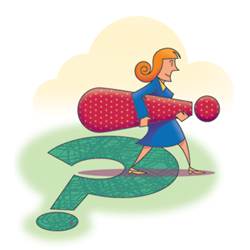philanthropy |


|
 ver since American Express Co. coined the term "cause-related marketing" in 1983, countless corporations have been jumping aboard the do-gooder express, bound for the PR holy land. Joining early leapers such as Target Corp. and Patagonia Inc., today's passengers have discovered that corporate philanthropy doesn't only buy you good karma - doing good can often mean doing well financially. ver since American Express Co. coined the term "cause-related marketing" in 1983, countless corporations have been jumping aboard the do-gooder express, bound for the PR holy land. Joining early leapers such as Target Corp. and Patagonia Inc., today's passengers have discovered that corporate philanthropy doesn't only buy you good karma - doing good can often mean doing well financially.
Recent research from a Cone Corporate Citizenship Study reveals that consumers value corporations' charitable efforts. Commissioned by Cone, the study revealed that 86 percent of consumers are very or somewhat likely to switch from one brand to another (price and quality being equal) if one brand is associated with a cause. The study also found that eight in 10 Americans claim corporate support of causes wins their trust in that company.
So where do exhibit marketers fit in to this cause-marketing mix? For the most part, they don't - or rather, they haven't leapt aboard the do-gooder train quite yet. While many companies publicize charitable activities on their Web sites and in press releases, only scraps of this information ever finds its way to their exhibits, where it can have a direct impact on would-be buyers.
To help get you in the goodwill groove, here are eight examples of exhibitors who harnessed the power of philanthropic activities - including everything from an in-booth bikeathon to a furniture donation for flood victims - which have generated feel-good vibes, boosted booth traffic, attracted media attention, fostered staff/attendee interaction, and even cut costs in the process.
|
Furniture for Flood Victims
With gas prices rocketing skyward, exhibit-transportation costs are enough to keep any exhibit manager up at night. In fact, you might be better off leaving some of your stuff behind at the show, rather than shipping it home with you.
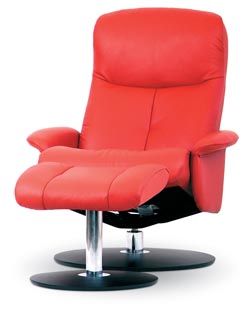 That's exactly what IntraNexus Inc. did after the 2007 Healthcare Information and Management Systems Society (HIMSS) Show in New Orleans. However, the provider of health-care information systems didn't simply trash part of its exhibit, it gave it to charity. That's exactly what IntraNexus Inc. did after the 2007 Healthcare Information and Management Systems Society (HIMSS) Show in New Orleans. However, the provider of health-care information systems didn't simply trash part of its exhibit, it gave it to charity.
Prior to the show, IntraNexus worked with exhibit house Alexis Exhibits to create a New Orleans-themed exhibit design for its 20-by-40-foot space. To create the appropriate look and feel, designers felt typical rental furniture just wouldn't cut it. Thus, IntraNexus purchased $2,800 worth of booth furniture, including two leather chairs and a matching love seat, two end tables, a coffee table, and eight wrought-iron stools.
As the company reassessed its logistics plans, however, it soon realized that this New Orleans-themed booth was of little use at shows outside of The Big Easy, which meant the furniture would need to be resold - or worse yet abandoned - after the show. So rather than trashing the furniture, or paying for its return shipment, IntraNexus donated it to the St. Bernard Project, an organization which helps New Orleans residents whose homes were damaged or destroyed in Hurricane Katrina.
During the show, the booth contained no mention of the donation, but IntraNexus made sure the local and at-show press received the news. Thus, the company's contribution generated a press mention in the show daily, which sent attendees scurrying to the booth to find out what all the humanitarian hubbub was about.
The donation also saved IntraNexus an estimated $500 in shipping charges (not to mention storage and disposal fees), while local media coverage extended the company's visibility long after the show.
|
Stop and Paint the Roses
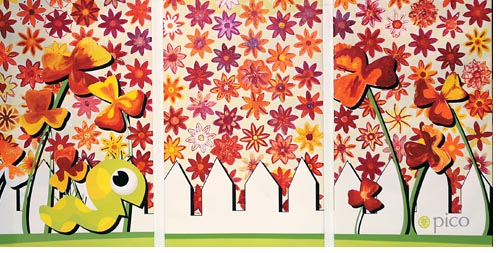 How do you set your exhibit apart from hundreds of other companies begging for attendees' attention? You offer something different, which is exactly what Pico International Inc., a global event-marketing firm headquartered in Hong Kong, did at EXHIBITOR2008 in Las Vegas. How do you set your exhibit apart from hundreds of other companies begging for attendees' attention? You offer something different, which is exactly what Pico International Inc., a global event-marketing firm headquartered in Hong Kong, did at EXHIBITOR2008 in Las Vegas.
Not wanting to hand out mundane promotional trinkets, Pico decided to incorporate cause marketing into its exhibit program instead. The company felt tying in a philanthropic effort would give it an edge against its competitors and therefore increase leads, while providing attendees with an opportunity to support the Las Vegas community, which has played host to the thousands that attend EXHIBITOR Show each year.
Pico decided to help support the Nevada Childhood Cancer Foundation in Las Vegas. It then brainstormed ways it could involve attendees and help the NCCF. The company settled on a flat monetary donation of $3,500 to do its part, and came up with an interactive in-booth activity in the form of a 7-by-7-foot blank mural featuring a cheerful landscape dotted with flowers to involve attendees. Pico's plan was to invite attendees to visit the booth over the course of the show and complete the mural.
 The promotion started with an invitation - featuring an image of what the completed mural was meant to look like - e-mailed to Pico's client list, encouraging them to stop by the booth and help fill it in. When attendees got to the booth, the three-paneled mural consisted of blank, outlined flowers. Staffers handed attendees a brush and a palette with quick-dry paint and invited them to paint a flower. The promotion started with an invitation - featuring an image of what the completed mural was meant to look like - e-mailed to Pico's client list, encouraging them to stop by the booth and help fill it in. When attendees got to the booth, the three-paneled mural consisted of blank, outlined flowers. Staffers handed attendees a brush and a palette with quick-dry paint and invited them to paint a flower.
As attendees painted, Pico staffers explained the company's plan to donate the finished project to the Nevada Childhood Cancer Foundation, along with a check for $3,500. If attendees demonstrated particular interest in the charity, Pico accepted donations in the booth, and rewarded their philanthropic prospects with eco-friendly tote bags or recycled-leather journals (for donations of $10 and $50, respectively).
"Initially, we really didn't know what the participation level would be," says Pico marketing specialist Shauna Royston. "We had an alternative plan to have the children from the foundation finish the mural if it was not completed by attendees." But on the first day of the show, it became clear that wouldn't be necessary. "We had people lining up to paint a flower, with some participants spending between 15 and 20 minutes painting," she says. By the end of the show, nearly 400 people had stopped by the booth.
Pico staffers arranged to have the finished mural framed and accompanied it to the Nevada Childhood Cancer Foundation to have it permanently displayed in its building. In addition to Pico's corporate donation, it also presented several hundred dollars donated by booth visitors. The mural activity proved fruitful for Pico as well, generating a 90-percent increase in leads over the previous year.
|
Going Nowhere Fast
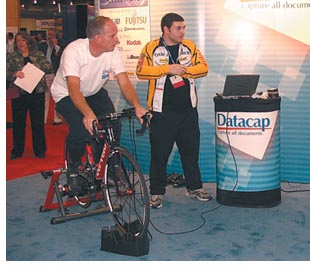 Bikeathons are great ways to raise money and awareness, but they're not exactly what you'd expect to find in an exhibit. However, this element of surprise is one of the reasons Datacap Inc. held a stationary bikeathon in its booth at the 2007 American Records Management Association International Conference and Expo (ARMA) in Baltimore. Bikeathons are great ways to raise money and awareness, but they're not exactly what you'd expect to find in an exhibit. However, this element of surprise is one of the reasons Datacap Inc. held a stationary bikeathon in its booth at the 2007 American Records Management Association International Conference and Expo (ARMA) in Baltimore.
Datacap, a document-capture and forms-processing company based in Tarrytown, NY, launched its bikeathon, officially named Cycle Faster, in 2005 as a way to raise money and awareness for charities such as the Lance Armstrong Foundation. Not only has the program raised more than $50,000 since its inception, it has also helped drive booth traffic at numerous shows, increase company awareness, and foster partnerships with the program's sponsors.
In the document-processing industry, people often refer to "increased cycle time" as a key benefit of effective scanning and capture systems. So when Datacap began the search for a fundraising initiative that could double as a booth activity, a cycling theme was the perfect fit.
Prior to each show, Datacap recruits its corporate partners to sponsor Cycle Faster. Donations between $1,250 and $5,000 allow sponsors to compete in the in-booth bikeathon. Datacap also includes sponsors' logos or company names in Cycle Faster promotional materials and press releases, and features them on in-booth signage. Plus, sponsor's logos are included on racing jerseys, which are worn by booth staffers and given away to attendees.
At the show, Datacap places a virtual-trainer bicycle front and center in its 20-by-30-foot space. Every 30 minutes, Datacap staffers gather attendees into seats near the bike and provide a three-minute product pitch as a rider warms up. Then, the race is on.
A 48-inch flat-screen monitor, visible to the rider and attendees, provides a "bikers'-eye-view" video of a hilly bike course. Meanwhile, the stationary bike mimics the course's difficulty, causing the competitor to strain up hills and coast down curving valleys, racing against the clock to finish the course in the fastest time during the show.
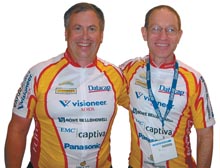 While sponsors represent the majority of competitors, attendees who make an on-site donation to the charity are also eligible to compete. Booth visitors who listen to the three-minute pitch receive Live Strong bracelets, Cycle Faster T-shirts, or water bottles, and they're eligible for a drawing to win a $900 gift certificate from International Bicycle Centers. While sponsors represent the majority of competitors, attendees who make an on-site donation to the charity are also eligible to compete. Booth visitors who listen to the three-minute pitch receive Live Strong bracelets, Cycle Faster T-shirts, or water bottles, and they're eligible for a drawing to win a $900 gift certificate from International Bicycle Centers.
To generate even more awareness, Datacap offers an award for the "most enthusiastic team" of race supporters, which ensures there's almost always a group of supporters in its booth. When a sponsoring-company employee is pedaling away, a raucous crowd of co-workers is usually nearby cheering him or her on.
At the end of the show, Datacap donates the money collected via sponsors and at-show donations to the selected charity, giving half in the name of the fastest female competitor and half in the name of the fastest male competitor from sponsoring companies.
After each show's competition has run its course, Datacap pedals off with stronger relationships with its sponsoring partners as well as increased leads. Compared to results prior to the program's inception, Datacap's Cycle Faster activity has helped increase leads by 20 to 30 percent.
|
The Giving Tree
Rather than giving booth visitors a branded pen or mug, Sherwood Design Engineers gave back to the planet at the 2007 Greenbuild International Conference and Expo.
Having developed a reputation for sustainable designs, the San Francisco-based engineers created what they called a "carbon-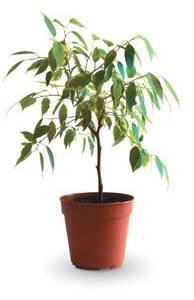 offset tree" in the corner of their 10-by-10-foot space. While the tree was little more than some branches protruding out of two stacked, open-framed cubes, it held roughly 50 green-and-white cards, which were attached to the branches via paper clips. offset tree" in the corner of their 10-by-10-foot space. While the tree was little more than some branches protruding out of two stacked, open-framed cubes, it held roughly 50 green-and-white cards, which were attached to the branches via paper clips.
As attendees approached the eye-catching tree, staffers invited them to take one of the cards and replace it with one of their own business cards. Staffers also explained that after the show, Sherwood would purchase more than 600 pounds of carbon offsets for each new card on the tree to help offset transportation emissions resulting from attendees' travel to and from the show. Meanwhile, the green-and-white cards given to attendees directed them to visit Sherwood's Web site to learn more about its carbon-offset program.
After the show, the carbon-offset portion of Sherwood's Web site featured the name and company affiliation of everyone who dropped off their business cards. And with more than 100 attendees participating in the activity, Sherwood purchased 60,000 pounds (30 tons) of carbon offsets from Native Energy, a Native-American-owned company that invests in wind-power projects - enough to offset the CO2 emitted by two full tanks of gas in a typical car for each of the program participants.
Furthermore, Sherwood followed up with the attendees who participated in the promotion via an e-mail that provided more information about the company, the carbon offsets, and Native Energy. The e-mails not only lent a bit of credibility to the program (in a time when carbon offsets are often viewed with cautionary skepticism), they served as yet another touch point for the company to interact with prospects from the show.
With little more than some branches, a few business cards, and a stellar environmentally conscious idea, Sherwood created a memorable one-off promotional activity that helped reinforce its commitment to sustainability - and generate 100 leads in the process.
|
A Wing and a Prayer
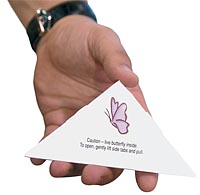 Exhibit Fair International Inc. recently created an in-booth philanthropic exhibit activity that had attendees all aflutter - literally. In its booth at EXHIBITOR2008, the Las Vegas-based exhibit-marketing firm gave attendees live butterflies in exchange for a $10 donation to the Make-A-Wish Foundation. Exhibit Fair International Inc. recently created an in-booth philanthropic exhibit activity that had attendees all aflutter - literally. In its booth at EXHIBITOR2008, the Las Vegas-based exhibit-marketing firm gave attendees live butterflies in exchange for a $10 donation to the Make-A-Wish Foundation.
The inventive traffic builder was the brainchild of EFI's general manager, Costas Varkarotas, whose child received a wish from the foundation in 2006. "We wanted to continue our support for the Make-A-Wish Foundation and to highlight the positive transformation our company has made in the last few years," Varkarotas says. Those changes included changing ownership, a growth in revenue and employees, and positive changes in the company's products, capabilities, and services.
While approximately 15 live butterflies were visible within a semi-transparent enclosure built into the exhibit's back wall, roughly 100 butterflies were housed in individual climate-controlled boxes within the booth. The cool temperature in each foam box meant the butterflies remained in a restful hibernation-like state prior to release.
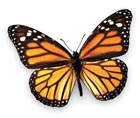 As attendees approached the booth, staffers informed them about the $10 donation and explained that many Native American tribes believe that a butterfly is a sacred creature, one capable of granting a wish. Thus, after the show, attendees were supposed to whisper a wish to their butterfly before releasing it, so that once freed, the butterfly would turn that wish into reality. As attendees approached the booth, staffers informed them about the $10 donation and explained that many Native American tribes believe that a butterfly is a sacred creature, one capable of granting a wish. Thus, after the show, attendees were supposed to whisper a wish to their butterfly before releasing it, so that once freed, the butterfly would turn that wish into reality.
While the activity had a profound effect on many attendees, it also generated lofty results for EFI. Although the company hoped to raise $1,000 for the Make-A-Wish Foundation, it actually raised $1,200. What's more, it generated approximately 120 leads, roughly 20 percent above its goal, as well as a memorable impression that lasted long after the show.
|
The Tchotchke Tchallenge
Secure Computing Corp., a provider of Internet-security software and appliances in San Jose, CA, didn't initially have philanthropic goals in mind when it began planning its booth for the 2007 RSA Conference in San Francisco. Rather, a mandate from its new senior vice president of marketing demanded the trade show team increase visibility while cutting costs by 25 percent.
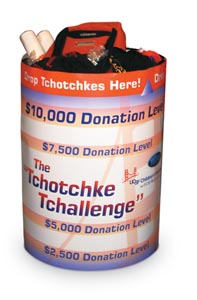 Scratching their heads for a solution, the team met for a marathon brainstorming session. Collectively, they figured attendees had more pens, T-shirts, and stress balls than they'd ever need. So Secure Computing figured it could save the cash it typically spent on branded giveaways and ask attendees to drop other exhibitors' swag into a simple $7 garbage can. If attendees filled the can by the end of the show, Secure Computing promised to donate the can's contents to a local children's hospital along with a $10,000 check. The company historically spent at least that, if not more, on giveaways; plus, it hoped the activity's PR and traffic-building benefits would far outweigh the tax-deductible $10,000 donation. Scratching their heads for a solution, the team met for a marathon brainstorming session. Collectively, they figured attendees had more pens, T-shirts, and stress balls than they'd ever need. So Secure Computing figured it could save the cash it typically spent on branded giveaways and ask attendees to drop other exhibitors' swag into a simple $7 garbage can. If attendees filled the can by the end of the show, Secure Computing promised to donate the can's contents to a local children's hospital along with a $10,000 check. The company historically spent at least that, if not more, on giveaways; plus, it hoped the activity's PR and traffic-building benefits would far outweigh the tax-deductible $10,000 donation.
In addition to goal lines on the garbage can that marked attendees' progress, the can featured inexpensive graphics that explained the activity - dubbed the Tchotchke Tchallenge - and prompted attendees to fill it to the hilt with whatever they could find.
By the end of the show, attendees had filled the can to overflowing, so Secure Computing gave the items and a $10,000 check to the University of California, San Francisco Children's Hospital. As anticipated, it was money well spent, as the Tchotchke Tchallenge generated show-wide visibility and repeat attendee visits. Plus, Secure Computing cut its total-booth costs by 25 percent and generated a whopping 210 leads, 10 percent more than its goal.
The strategy was so successful, in fact, that Secure Computing recycled it at Interop 2006 in Las Vegas. This time the Las Vegas chapter of The Children's Heart Foundation received the Interop tchotchkes and the $10,000 check. At show's end, Secure Computing had generated 445 leads, more than double its total at RSA. Plus, the activity generated press attention, resulting in articles in Network World, Information Week, and Secure News, among others.
|
Big-Ass Donation
At the 2007 Greenbuild International Conference and Expo, the Big Ass Fans Co. had some explaining to do. That's because after one glance at its big-ass fans - behemoths up to 24 feet in diameter - most people assume the fans are also big-ass energy hogs. Truth is, however, the fans use their immense size, rather than electricity-guzzling speed, to move massive amounts of air over large spaces, creating a sort of wind-chill effect that makes the temperature feel between 4 and 16 degrees cooler.
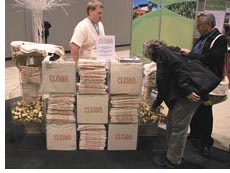 To dispel any myths about its products, while touting its commitment to eco-friendly heating and cooling options, Big Ass Fans stirred up a giveaway with a philanthropic twist. To dispel any myths about its products, while touting its commitment to eco-friendly heating and cooling options, Big Ass Fans stirred up a giveaway with a philanthropic twist.
Prior to the show, Big Ass Fans designed organic-cotton T-shirts branded with its Web site and text that read, "Rethink the dress code. CLO.08." The shirts were based on the premise that if people dressed according to their environment, offices could set their AC temperatures higher, and thus lower energy consumption. While only the freakiest of Green freaks likely understood the reference, CLO.08 is the thermal-insulation value of a T-shirt as defined by the American Society of Heating, Refrigerating, and Air-Conditioning Engineers Inc. (ASHRAE).
At the booth, T-shirt-clad staffers distributed shirts to attendees in exchange for small donations - $1 if attendees donned the shirt, and $2 if they put the shirt in their bag. After the show, all donations along with matching funds from Big Ass Fans went to ASHRAE, earmarked for research regarding eco-friendly heating and cooling methods.
With hundreds of attendees choosing to wear the shirts at the show, the cool promotion provided Big Ass Fans with show-wide visibility. In addition to raising more than $2,700 for ASHRAE, the giveaway also allowed staffers to explain the benefits of the company's fans - and to prove that its eco-friendly claims aren't just a bunch of hot air.
|
Cootie Contribution
When's the last time you played with a cootie catcher? You know, those folded paper gizmos you'd stick on your fingers and furiously flap open and closed to predict which one of the other fifth graders you were going to marry?
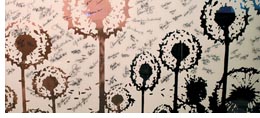 Live-communications company EWI Worldwide paired this unforgettable childhood toy with a compassionate children's charity, the Suite Dreams Project, to create a one-off activity in its booth at EXHIBITOR2007. Based in Rochester, MI, the Suite Dreams Project is a nonprofit organization that uses designers, artisans, and volunteers to create beautiful, healing environments for seriously-ill children in homes, hospitals, and communities. Live-communications company EWI Worldwide paired this unforgettable childhood toy with a compassionate children's charity, the Suite Dreams Project, to create a one-off activity in its booth at EXHIBITOR2007. Based in Rochester, MI, the Suite Dreams Project is a nonprofit organization that uses designers, artisans, and volunteers to create beautiful, healing environments for seriously-ill children in homes, hospitals, and communities.
But rather than publicize the activity before the show, EWI Worldwide wanted attendees to be pleasantly surprised by the memorable activity. Thus, it didn't mention it in any of the multiple pre-show tactics it used to drive traffic to its booth.
At the show, staffers swiped visitors' badges and then handed them off to a designer who asked them if they remembered the cootie-catcher game from childhood. The designer then picked up a pre-made cootie catcher with dollar amounts of $10, $15, and $250 hidden beneath color- and number-coded flaps. Then the flapping began in earnest.
First the designer asked the attendee for his or her first name and manipulated the cootie catcher to spell it out, opening it one time for each letter to reveal a selection of colors or numbers. Next, the attendee selected one of the colors or numbers. The designer then spelled out the color, opening the cootie catcher once for each letter, or if the attendee selected a number, the designer flip-flapped the cootie catcher that number of times. Either way, the cootie catcher again revealed a choice of colors or numbers.
Finally, after the attendee selected a color or number, the designer opened the appropriate flap, revealing text indicating $10 or $15, or a gold-star sticker, representing $250. The designer then explained that EWI Worldwide would donate that amount to the Suite Dreams Project in the attendee's name.
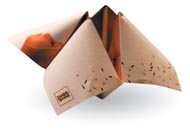 The designer then led the attendee to the charity-board display to sign his or her name and write down the dollar amount. The 10-by-4-foot semi-transparent charity board soon became an attention getter in itself as the growing number of names and dollar amounts lured in passersby. The designer then led the attendee to the charity-board display to sign his or her name and write down the dollar amount. The 10-by-4-foot semi-transparent charity board soon became an attention getter in itself as the growing number of names and dollar amounts lured in passersby.
By the time each cootie-catcher activity was complete, designers and attendees had moved beyond opening conversations, allowing designers to easily shift the conversation toward more business-oriented topics and direct qualified attendees to a quiet conference area to talk serious business.
At show's end, attendees had wracked up $5,000 in cootie-catcher dollars on the charity board. Thus, EWI Worldwide gave $5,000 to the Suite Dreams Project, which sent personalized thank-you notes to each participating attendee. Sometime this year, EWI Worldwide will follow up with participants to reveal how those donated dollars were spent.
For EWI Worldwide, the charitable activity was the perfect conversation starter, and the charity wall became an aisle-side traffic stopper to boot. Plus, it estimates the activity increased the time staffers spent with attendees by roughly 300 percent compared to the previous year. e
|
|
|




 ver since American Express Co. coined the term "cause-related marketing" in 1983, countless corporations have been jumping aboard the do-gooder express, bound for the PR holy land. Joining early leapers such as Target Corp. and Patagonia Inc., today's passengers have discovered that corporate philanthropy doesn't only buy you good karma - doing good can often mean doing well financially.
ver since American Express Co. coined the term "cause-related marketing" in 1983, countless corporations have been jumping aboard the do-gooder express, bound for the PR holy land. Joining early leapers such as Target Corp. and Patagonia Inc., today's passengers have discovered that corporate philanthropy doesn't only buy you good karma - doing good can often mean doing well financially. 











